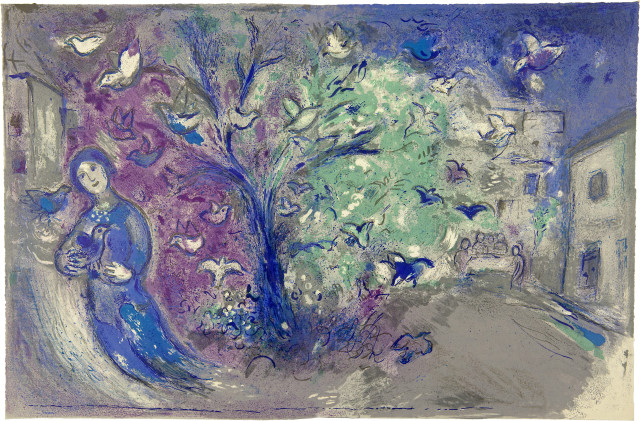- FR
S’inscrire
- Acheter
- Vendre
- Plus
- Galerie
- Commerce d'art
- Maison d'Édition
- Kornfeld aujourd’hui
- L'histoire de la Maison
- Informations





Witebsk 1887 - 1985 Saint-Paul-de-Vence
1961
In loose leaves and sheets, in orig. wrappers, in orig. hln. wrappers and orig. slipcase. 2 volumes
43,3x34x11,2 cm, slipcase
Signed "Marc Chagall" by the artist in pen and ink on the imprint and numbered "149". One of the 250 copies numbered in Arabic in the imprint of a total edition of 270 copies. With 42 colour lithographs, 16 of which are double-sided
Patrick Cramer, Marc Chagall, Catalogue raisonné des livres illustrés, no. 46
Fernand Mourlot, Chagall Lithographe, Nrn. 308-349
Private collection Norway
On wove paper "Arches" with watermark. The slipcase with slight traces of use. Impeccable, fresh in colours copy in the publisher's original presentation
In "Daphnis et Chloé", the 2nd century AD Greek poet Longus tells the story of the two abandoned children who were taken in by the shepherds Lamon and Dryas. Only after many years were they recognised as children of wealthy parents from Mytilene. They did not return home, however, but stayed in the countryside and celebrated their wedding there. The publisher Tériade came from Mytilene and had a special relationship with the text
Certainly the most important work by the artist illustrated in colour lithographs
1961
In losen Blättern und Bogen, in Orig.-Umschlägen, in Orig.-HLn.-Umschlägen und Orig.-Schuber. 2 Bände
43,3x34x11,2 cm, Kassette
Im Impressum vom Künstler in Feder in Tinte signiert "Marc Chagall" und nummeriert mit "149". Eines der 250 im Impressum arabisch nummerierten Exemplare einer Gesamtauflage von 270 Exemplaren. Mit 42 farbigen Lithographien, wovon 16 doppelseitig
Patrick Cramer, Marc Chagall, Catalogue raisonné des livres illustrés,
Fernand Mourlot, Chagall Lithographe, Nrn. 308-349
Privatsammlung Norwegen
Auf Velin "Arches" mit Wasserzeichen. Der Schuber mit leichten Gebrauchsspuren. Tadelloses, farbfrisches Exemplar in der ursprünglichen Präsentation durch den Verleger
In "Daphnis et Chloé" erzählt der griechische Dichter Longus im 2. Jahrhundert n. Chr. die Geschichte der beiden ausgesetzten Kinder, die von den Hirten Lamon und Dryas aufgenommen wurden. Erst nach vielen Jahren wurden sie als Kinder wohlhabender Eltern aus Mytilene erkannt. Sie kehrten aber nicht nach Hause zurück, sondern blieben auf dem Lande und feierten dort ihre Hochzeit. Der Verleger Tériade stammte aus Mytilene und hatte zu dem Text eine besondere Beziehung
Sicherlich das bedeutendste, in farbigen Lithographien illustrierte Werk des Künstlers






